Pūrākau o ngā kura Te Tai Tokerau
TERM 1 2024
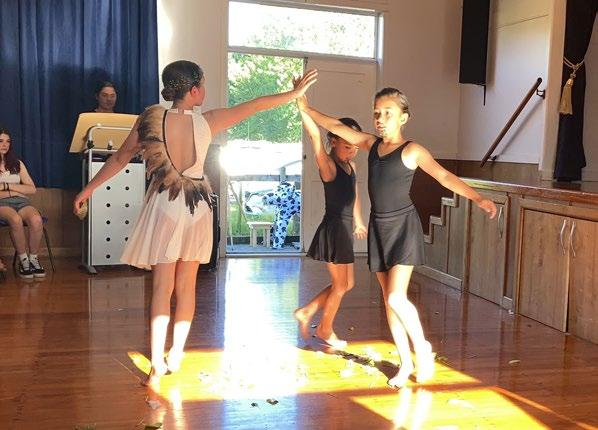
Tamariki explore identity through movement and storytelling
Maromaku School’s I Am Legend project, where movement, storytelling, and diversity intertwine to empower young hearts and minds.
Students take charge of their learning environment
Ruakākā Primary School’s Play Box and Physical Activity Kits have revolutionised break times, offering inclusive play and fitness options that enrich the school’s vibrant culture.

Intergenerational collaboration at Tinopai School
Tinopai scholl create space for intergenerational connection within the school environment.
Term 1 2024 Editors Note
Nau mai, haere mai to Pūrākau o ngā kura Term 1 2024 featuring stories highlighting Kaupapa here in Te Tai Tokerau.
This term we are celebrating Maromaku School’s I Am Legend project where tamariki explored identity through the use of movement and storytelling. Then at Tinopai School, we see how community connection has enriched tamariki experiences through taking time to teach how to grow and harvest kai. In the Tama tū, Tama ora section we see examples inspired by all things play from Rūakākā School, Manaia View Primary and Selwyn Park School. Play is a valuable tool in the movement toolbox, has so many benefits for learning as well and did you know it’s not just for the younger generations, play is for adults too and you can find some great ideas on what that might look like for you and your colleagues or whānau by scanning the QR code on the back page of this edition.
You will see play being used in various ways from incorporating physical activity kits into the classroom, the use of Play Boxes during break time to keep tamariki active and engaged and utilising student voice to explore what can be create a quality play experience.
Lastly we see a story on rescuing equipment in the PE shed inspired by Sewlyn Park Primary School bringing back to life a frisbee golf set that was made over 15 years ago!
Read on for the stories from your schools. Healthy Active Learning Te Tai Tokerau.
HAUORA – WELLBEING
He hauora, Te taonga –Health is wealth
Tamariki Explore Identity Through Movement and Storytelling
NĀ TŌ ROUROU, NĀ TAKU ROUROU - COMMUNITY CONNECTIONS
Nā tō rourou, nā taku rourou, ka ora ai te iwi -
With your food basket and my food basket, the people will thrive.
TAMA TŪ, TAMA ORA - QUALITY PHYSICAL ACTIVITY
Tama tū, Tama oraYou stand, you live Intergenerational Collaboration at Tinopai School
Innovative Play Initiatives
the School Environment
Students Take Charge of Their Learning Environment 15
Contents
04 Forgotten... A
of rescuing unused equipment in the PE shed 18
tale
08
11
Transforming
Tamariki explore identity through movement and storytelling
 Maromaku School’s I Am Legend project, where movement, storytelling, and diversity intertwine to empower young hearts and minds.
Maromaku School’s I Am Legend project, where movement, storytelling, and diversity intertwine to empower young hearts and minds.
Maromaku is a predominantly farming community located just south of Kawakawa. In Maromaku, you will find a tight knit community with a local school of 27 students from Year 0 to Year 8. Throughout 2023, Maromaku School worked on a project aimed at celebrating diversity and empowering young minds, the I Am Legend project. Designed with tamariki aged 5-11 years in mind, the programme goes beyond traditional dance instruction, weaving together storytelling, cultural exploration, inclusivity and movement. It is a journey of self-discovery, empowerment, and celebration of uniqueness. The programme, spanning across 10 weeks, invites tamariki to explore their identities through movement, guided by themes of Māori atua such as Ranginui, Tangaroa, Tāne Mahuta, Papatūānuku, and Tāwhirimātea.
Maromaku School Principal, Paula Ashcroft, says, “It is just so hard to portray the feeling of accomplishment that was felt by everyone involved”. She notes how the kaupapa led to student empowerment and increased confidence in their abilities.

One of the core aims of the I Am Legend project was to break down barriers to participation commonly faced by tamariki who may not typically particpate in traditional sports. Through dance and movement, tamariki who may traditionally not engage in sporting activities found avenues for active participation and leadership roles within the programme. This consideration extended to all, regardless of background or ability, seeking to keep tamariki active in unique ways while aiming to remove
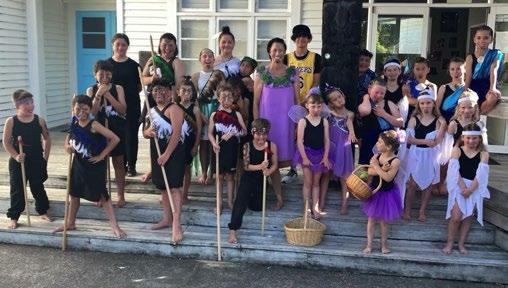 Hauora
Hauora
5
Above: Tamariki ready for their performance

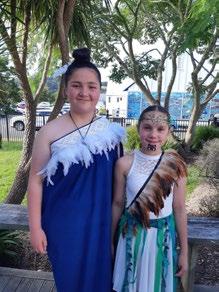
dance and movement stereotypes.
“We want our tamariki to thrive actively and feel part of something bigger that allows them to see the best version of themselves while celebrating and embracing their diversity and uniqueness.” Adrienne
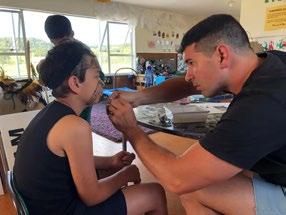
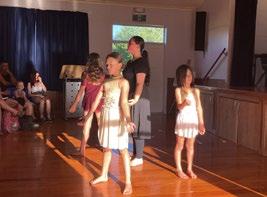
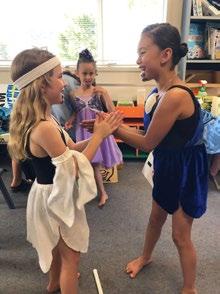
Wellbeing 6
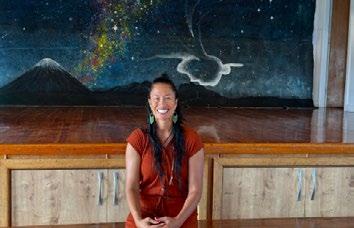

Kehoe
It’s all part of the process
As the weeks progressed, tamariki immersed themselves in dance and movement sessions, guided by Adrienne a parent and Board of Trustee member. The programme concluded with a performance, not only for the school community but also for neighbouring schools such as Motatau and Hikurangi, with Maromaku travelling, or schools visiting them. This created an opportunity for I Am Legend to also serve as an educational platform, promoting social awareness of ways to move that aren’t traditional sport and how a small school is capable of putting on such a perfomance.
“Through dance, we tell stories. Stories of our culture, our history, and most importantly, stories of who we are,” remarks Adrienne.
Tamariki at the centre
At the heart of I Am Legend is collaboration. The programme actively seeks input from tamariki and their whānau, ensuring that their voices shape the creative process. Senior students and a group of girls aged 7-11 were instrumental in developing characters and ideas for the performance, fostering a sense of ownership and inclusivity.
The “I Am Legend” dance programme stands as a testament to the transformative power of art and the
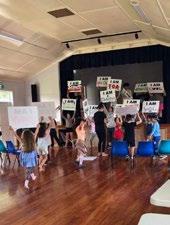
resilience of young minds. It is more than a performance; it is a reflection of Maromaku community coming together to uplift, empower, and celebrate the next generation.
Community Impact Award
In March 2024, Maromaku School was recognised with receiving a community impact award for the I Am Legend project, acknowledging how this kaupapa created more community connections and built relationships all around. The project not only showcased the talents and growth of the students, but also inspired neighbouring schools, highlighting the potential for creative initiatives to bring about positive inspiration. The lasting effects of the initiative continue to show in the community, paving the way for future kaupapa and changing the culture of the school for the better.
Next Steps
Adrienne is currently focused on securing funding to sustain the momentum of the project. In a broader context, she has her sights set on a matariki focused kaupapa. Adrienne remains committed to leveraging creative expression to expand childrens movement experiences, aiming to bring new dimensions of learning and growth to their educational journey.

Hauora 7
Tamariki practising in the hall.
Interview with Adrienne on the I am Legend programme Scan to watch
Sam Tracey
kaimahi supporting this school
Intergenerational collaboration at Tinopai School
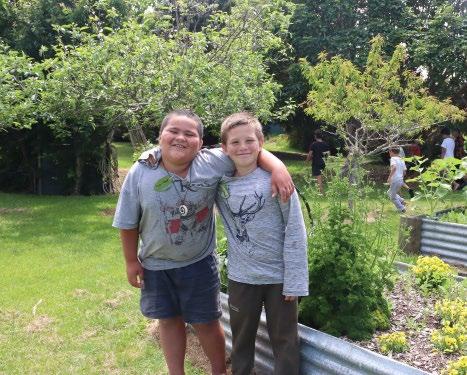 Tinopai school create space for intergenerational connection within the school environment.
Tinopai school create space for intergenerational connection within the school environment.
In the small Northland coastal township of Tinopai, nestled on the northern Kaipara Harbour, beats the heart of this close community. Tinopai School, opened in 1916, is the hub of this proud township. It is not just a school, but a place to meet, relax, chill in for a while and, of course, play. In a special partnership between the school and the local community, a dedicated area for learning and nutrition has been nurtured and developed. This space, a community garden, is located within a picturesque corner of the school’s expansive outdoor spaces. It is meticulously maintained by local grandparents, tamariki and school staff and its benefits extend well beyond the borders of the Tinopai School grounds.
Grandparents and the wider Tinopai community have become important contributors, dedicating time and expertise to support tamariki in tending to the gardens and the pataka kai, located at the school entrance. This intergenerational collaboration not only imparts valuable skills but also strengthens the bonds between the older and younger members of the local community.
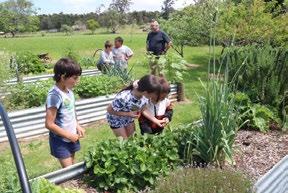
At the heart of this community engagement is a group sharing knowledge to students on the art of caring for gardens and cultivating vegetables for the school’s pataka kai. The hands-on approach not only teaches practical, life-long gardening skills but also a sense of pride and ownership among the tamariki. And, as one student was overheard commenting, “It’s a great workout for my fingers!”.
Tinopai School’s dedication to environmental stewardship is evident in its alignment with the kaupapa as an Enviroschool, having recently been awarded Silver status. The garden project exemplifies the school’s commitment to sustainability, ecological awareness, and the interconnectedness of the community with the environment.
The EnviroSchools programme has been woven into the fabric of Tinopai School’s garden initiative, providing a holistic framework for understanding the environmental impact of their actions. Students learn not just to cultivate plants but to do so in harmony with nature, considering the broader ecological implications.

Nā to rourou, nā taku rourou
9
Above: Tamariki making huts.
Above: Checking if the strawberries are ready.
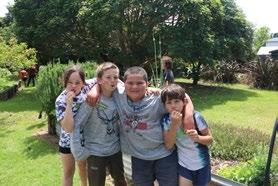
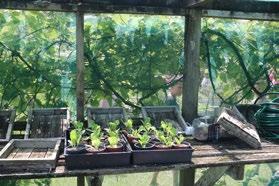
Some of the other community projects that the school has engaged in include “The Whitebait Connection” (a freshwater conservation education programme), The Tinopai Resource Management Unit (involving students learning about the restoration of wetlands, planting and identifying the mauri of the wetlands and whenua) and the Kaipara Moana Remediation programme (schools and their communities working together to facilitate the restoration of wetlands in Tinopai such as the Puapua Creek).
Looking forward, Tinopai School envisions a continuation of this journey with a focus on a garden-to-plate initiative. The school aims to utilise the produce from the garden for its school lunches, fostering a deeper connection between the students and the food they consume. This forward-thinking approach aligns seamlessly with the school’s commitment to sustainability and community engagement.
Through regular communication and engagement with whānau, Tinopai School ensures that the wider community is not just
informed but actively involved in the school’s activities. The garden serves as a meeting point, a collaborative space where knowledge is shared, relationships are strengthened, and a sense of belonging is cultivated and sustained.
Maree Rossiter, the Principal of Tinopai School, is full of praise for her local community. “Tinopai is an amazing community, it is so supportive.”
To maximise this connection, she also ensures that the school operates an “open door” policy where locals can drop in and visit anytime. Many visit, donating seedlings, plants, fruit and other horticultural supplies.
As an embodiment of the school’s values, the garden project stands as a testament to the power of collaboration. It is a space where community members, grandparents, tamariki, and kaiako work alongside eachother.
In Tinopai, the school’s garden is a living example of how a shared commitment to the environment can foster deep connections among community members echoing the sentiment that indeed, “Tinopai School is Tinopai.”
Community Connections 10
Above: Eating produce from the garden.
Above: Seedlings nearly ready for planting.
Innovative Play Initiatives Transforming the School Environment
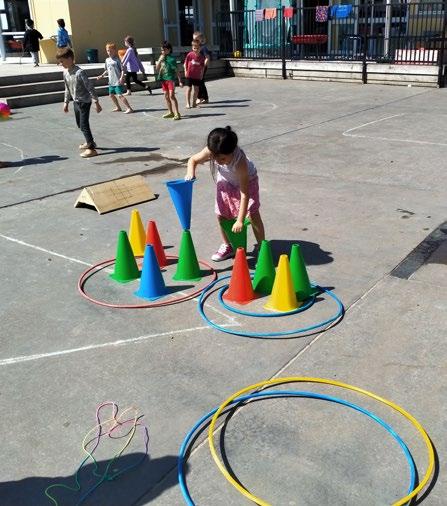
Ruakākā Primary School’s Play Box and Physical Activity
Kits have revolutionised break times, offering inclusive play and fitness options that enrich the school’s vibrant culture.
In a refreshing approach to promoting physical activity and fostering vibrant schoolyard dynamics, Ruakākā Primary School has introduced a series of initiatives that have taken its playground experience to new heights. Spearheaded by an enthusiastic staff member, these initiatives not only provide an opportunity for tamariki to engage in unstructured play but also offer a unique blend of fun and fitness.
The school’s journey into redefining play began with the introduction of their self made Play Box and Physical Activity kits. The Play Box concept aimed to provide tamariki with a variety of equipment beyond traditional sports gear. The driving force behind this initiative was a desire to ensure all tamariki, regardless of their interests, have the chance to engage in playful activities during break times. The Play Box also served as a solution to the challenge of limited space, following the development of new classrooms which now take up a large area of the school’s fields, giving tamariki a new way to engage with their environment to participate in activities of their choice.
The Play Box sought to create a space where participation was inclusive, safe and varied for younger tamariki who were hesitant
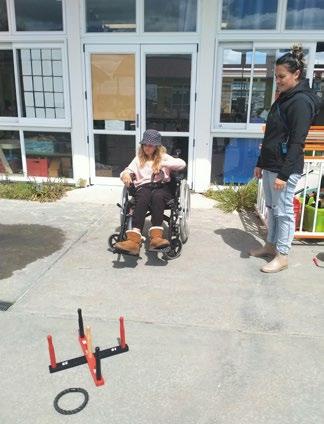
to get involved in other activities and spaces while they were finding their feet amongst a busy school with lots of active, older tamariki. By allowing children the freedom to choose their activities and ensuring the equipment was easily accessible, the Play Box became a hit among students. The introduction of student play advocates and sports monitors further enhanced the experience, encouraging children to
join in the activities and providing assistance when needed. Due to a rise in the school roll along with the addition of the Play Box, a kaiako is allocated to the Play Box as part of their duty on the lunchtimes that it is utilised. This is currently three lunchtimes a week, creating consistency but keeping the novelty of it alive. Other options such as Jump Jam are offered on the days the Play Box isn’t there.
12
Tama tū, Tama ora
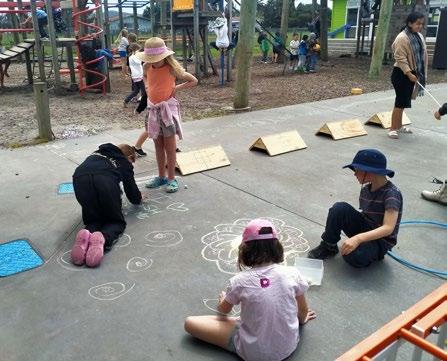
Addressing the need for a more organised distribution of sports gear, the school also implemented a system for allocating equipment during lunch breaks. This initiative aimed to streamline the process, ensuring that sports gear was readily available while maintaining order and responsibility.
Sports monitors played a crucial role in managing the distribution, creating a seamless and efficient system of signing out gear at the beginning of break times and signing back in at the end.
Integrating physical activity during curriculum time was another aspect that was reassessed. Understanding the challenge teachers faced in
organising physical activity during class time, the school introduced Physical Activity Kits (PA Kits). These kits were designed not only to make gear easily accessible but also to empower teachers with the tools and knowledge to integrate physical activity into their classes. The initiative not only promoted physical wellbeing but also reduced the barriers for teachers, making it easier to engage students in active regular breaks.
Feedback from kaiako includes gold such as the PA kits being handy due to ease of access, how not needing to go and find the gear removes that barrier, knowing what gear they have so can they plan around it, how they can use these resources for other areas in class, they are time efficient
13
Quality Physical activity

(not having to go to the PE shed), compact/easy to take anywhere in the school, how they bring a bit of fun to the day and that they have been great for neurodiverse students, and help them with building Te Whare Tapa Wha. They also created an opportunity to throw physical activity over to the kids to come up with ideas and be creative.
The Play Box, lunchtime sports gear distribution, and PA Kits were introduced simultaneously, and funded through a collaborative effort. Despite initial challenges, including logistics and gear availability, the rollout was well-executed. Staff meetings and practical sessions helped ensure that teachers were not only aware of the initiatives but also equipped with the necessary skills to incorporate them into the school day. The rollout of the PA kits was supported by the Sport Northland Healthy Active Learning team who spent time running through sessions with individual classes and talked to kaiako about the games, the gear, cross curricular links as well as adaptations that could be made to ensure all tamariki are able to participate. At the end of the day, a full staff session was run to go through the logistics of rolling these PA kits out and talk through possible challenges that they may face.
The success of these initiatives was attributed to their school-wide implementation, with enthusiastic support from the school’s leadership team and the wider school staff. The Play Box, in particular, became a focal point for students, providing a safe and engaging space for unstructured play. The school plans to continue refining and expanding these initiatives, with ongoing efforts to replenish and diversify play equipment, engage teachers through regular upskilling, and explore the possibility of integrating these activities into staff meetings.
This school’s innovative approach to play has not only transformed break times but has also created a positive impact on the overall school culture. By prioritising inclusivity, accessibility and teacher involvement, the initiatives have become an integral part of the school’s commitment to the wellbeing and active engagement of its students.


14
tū, Tama ora
Natalie Wilcock Tama
kaimahi supporting this school
Sam Tracey
Students Take Charge of Their Learning Environment
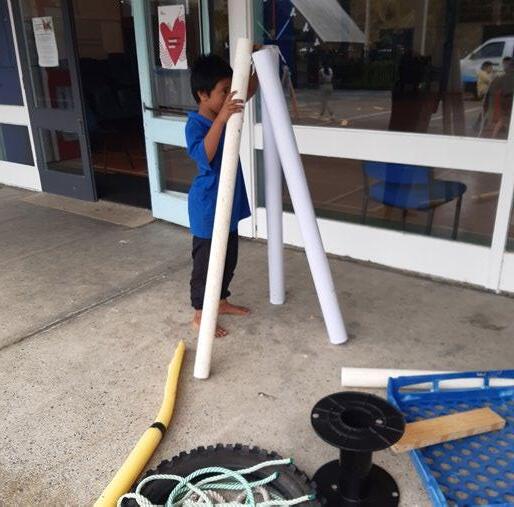 Tamariki at Manaia View School create new loose parts play box initiative for all to use.
Tamariki at Manaia View School create new loose parts play box initiative for all to use.
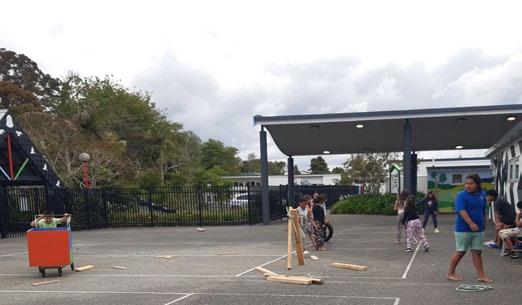
Manaia View Primary School has been undertaking the process of redefining the traditional classroom, giving students and educators a sense of ownership and pride in their learning environment. The catalyst for this change is the Loose Parts Play Boxes initiative, which was implemented at Manaia View during 2023 to embrace creativity, movement, and hands-on learning.
Initiated by Sonya and Ben, Manaia View Primary School kaiako who recognised the need for a fresh approach post-COVID-19 challenges, the Loose Parts Play Boxes initiative aims to empower students by involving them in the creation of their learning resources. Sonya played a pivotal role in bringing the vision to life, emphasising diversity and inclusivity, especially for students facing academic difficulties.
“It’s not just about the physical elements; it’s about instilling a mindset of constructive thinking and collaboration” says Sonya.
Tamariki took part in the entire process from collecting the equipment needed to build the Loose Parts Play Boxes to working alongside Hard Materials Teacher Don MacDonald Spice to build the boxes and trolleys so that the boxes can easily be transported around the school as needed.
The journey wasn’t without its challenges. Accidental material disposal and resource scarcity posed hurdles, but the team persevered. They tapped into local resources, securing materials from tire shops, farms, and even repurposed trolleys that had been discarded. The Loose Parts Play Boxes evolved beyond collections of loose parts; they became a commitment to fostering creativity, problem-solving, and collaboration among students.
Tama tū, Tama ora 16
Above: First group of students getting involved during break time.

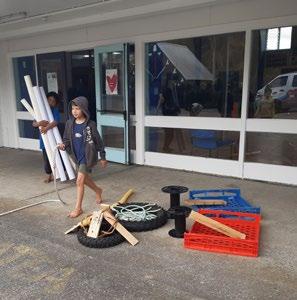
Natalie and Sam, Sport Northland Healthy Active Learning kaimahi, played a positive role by reshaping the perspective on physical education. They infused it with the spirit of play and exploration, shifting perspectives and promoting the benefits of unstructured play as an essential tool for learning.
Addressing health and safety concerns, Sonya highlighted the implementation of safety measures and a thorough risk management process with the initial implementation of new equipment into the school environment. Positive feedback received from the school community has outlined how the initiative aligns with the school’s values of unity, responsibility, and trust. Kaiako Ben Spiers encourages other schools to embrace the concept, tailoring it to fit the unique needs and dynamics of each learning community.
“It’s about encouraging creativity, problem-solving, and effective communication,” Ben says. “The learning doesn’t stop in the classroom; it extends to every corner of our school, creating a space where students can truly play, learn, and grow together.”
The Loose Parts Play Boxes initiative at Manaia View Primary School have become a testament to the transformative power of imagination, resourcefulness, and dedicated educators shaping the learning environment.


Quality Physical activity
17
Above: Students getting creative with the loose parts play equipment.
Natalie Wilcock
kaimahi supporting this school
Sam Tracey
Forgotten... A tale of rescuing unused equipment in the PE shed
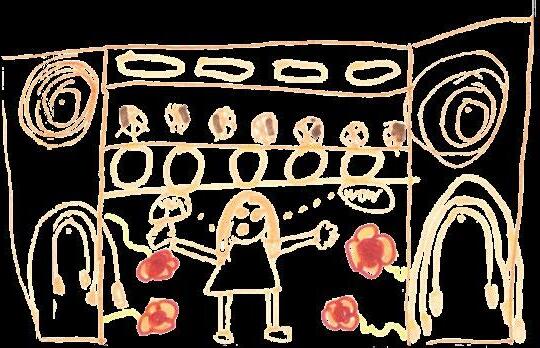 Story inspired by Selwyn Park school
Picture illustrated by Millie age 7.
Story inspired by Selwyn Park school
Picture illustrated by Millie age 7.
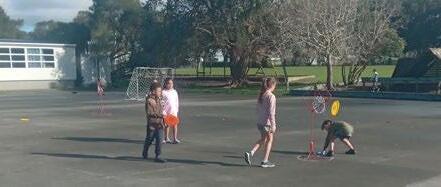
Wedged in the deepest, darkest corner of the musty PE shed I lay forgotten, abandoned, waiting. There was a time, long ago when I was the centre of attention. The star of every play time, the creator of joys of laughter and ear-to-ear smiles, but as the years went by, I found myself pushed aside by newer, shinier, more novel equipment. Equipment that was “easier”, faster to set up. My once vibrant colours faded, and layers of dust settled over me and I was relegated to live with the mis-matched bibs, deflated footballs, behind the ancient high jump mat with its stuffing seeping out of its seams.
Me, the old Frisbee Golf net. The one with the rusty stand and the frayed net. The game that tamariki used to love so much, set up themselves and play until the bell called them back inside. I knew the new cohort would love me if only I was given another chance. Instead, I watched from a distance as classes came and went, and the once familiar faces of excited children turned into distant memories. The laughter and shouts of my games became echoes, replaced by the silence of the PE shed. I wondered if I would ever feel the thrill of being out in the fresh air again, the rush of competition, and see the joy of selfmotivated success again.
Then, one day, the door to the shed creaked open. A beam of sunlight pierced through the darkness. I blinked, my slightly rusty surface absorbing the warm rays I remembered so well. Two pairs of curious
eyes stared at me with a mixture of intrigue and amusement. It was a Physical Activity Leader (PAL), sent to clean out the PE shed. “Hey guys, look at this! What is it!?” I heard. In raced 3 more PALs - the new generation of students, their faces eager to explore the forgotten corners of the PE shed, the forgotten pieces of equipment.
One of the students reached out and picked me up, dusting off the layers of “forgotten” that coated my surface. I was overcome with excitement, a longforgotten feeling that exuded through my metal core, my frayed rope net. The students examined me, turning me around and asking each other questions, making inferences about what I was used for and considering my potential.
“This thing is ancient!” one of them exclaimed with a grin.
“Yeah, but it looks like it could still be fun,” another replied. And just like that, I was brought back to life.
The group carried me out of the shed and onto the school’s field, where a makeshift Frisbee Golf course was marked with cones and some hand-crafted signs. Other students joined in, their faces lighting up as they saw how fun this relic could be. As the games began, the rhythmic thud of feet and the whoosh of frisbees filled the air.
Tama tū, Tama ora 19
Selwyn Park School tamariki playing frisbee golf.
When the bell rang, I was back in the hands of the student who had found me. They were sweaty and muddy and had a triumphant smile plastered across their face. They looked at me with a newfound appreciation, a recognition of the memories and experiences I held, the fun I could bring.
As they carried me back to the PE shed, I couldn’t help but feel a sense of contentment. I might have spent years in the shadows, forgotten and neglected, but I had been given a second chance. I had been the main character in the joy of play once more, the fun and connection that would stay with those students long after the game had ended. With that, I settled into my NEW place in the PE shed, not quite front and centre but no longer wedged in the deepest, darkest corner. The shed door was slid shut, the bolt slid across and there I sat, “this is so fun” “let’s play this tomorrow” ringing in my ears, knowing I would be sought out again.
I was no longer just a forgotten piece of equipment.
I was new, exciting and novel again; a cherished memory rekindled.
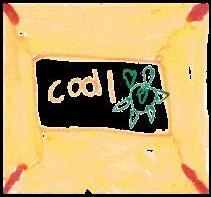
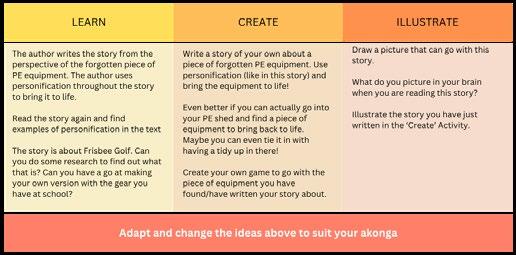


Quality Physical activity 20
Natalie
Wilcock
Leesa Andrewes
kaimahi supporting this school

Amy Murray
School Connector
Far North
No Hokianga ahau kei
Ahipara tōku kainga inaianei

Ebony Paaka
School Connector
No te whenua moemoea ahau engari e ngakautia ana ki Hokianga kei Ahiparapara ahau e noho ana.

Joel Quitta-Moses
School Connector
Hokianga
Te Tai Tokerau Healthy Active Learning Kaimahi

Ann Morrogh-Yates
Facilitator
Far North

Ashleigh Ellis
Healthy Active Learning Support
Whangārei

Erin Steel
Facilitator Lead
Whangārei

Gina Matiu
School Connector
Mid North-East

Kelvin Maxwell
Facilitator
I whānau mai au I te taha o te awa o Kirikiriroa
I rarai te maru o te maunga o Piriongia
He uri ahau no Īnia, No Kānata
Kei te noho au kei Whangārei

Lewis Wallace
Facilitator
Mid-North


Komene Marino
School Connector
E ngakau nui ana ki a Ihu Karaiti.
Ko te Āo hakinakina tōku kai I te ao, I te po.
He kura honongaahau ki Te Tai Tokerau


Deanna Saxon
Facilitator
Te Hiku o Te Ika

Jen Fielden
Healthy Active Learning Lead
No Kirikiriroa ahau kei
Whangārei tōku kainga inaianei

Leesa Andrewes
School Connector
Kaipara-Whangārei
No Dargaville ahau kei Baylys Beach tōku kainga inaianei

21
Natalie Wilcock
Facilitator
Whangārei-Kaipara area
Sam Tracey
School
Connector Whangārei-Kaipara area
Stacey Tipoki
School Connector Mid-North
Healthy Active Learning
What is Healthy Active Learning?
Healthy Active Learning is a joint government initiative between Sport NZ, Te Whatu Ora Health New Zealand, and the Ministry of Education to improve the wellbeing of tamariki and rangatahi through healthy eating and drinking and quality physical activity.

Scan to learn more about play for adults.

Scan to learn more about Healthy Active Learning in Te Tai Tokerau.
Sport Northland
97 Wetsern Hills drive, Kensington, Whangārei. www.SportNorthland.co.nz
Vision:
Purpose:
All Northlander’s moving more for enhanced wellbeing
To enrich Northlander’s lives by inspiring and enabling more movement


 Maromaku School’s I Am Legend project, where movement, storytelling, and diversity intertwine to empower young hearts and minds.
Maromaku School’s I Am Legend project, where movement, storytelling, and diversity intertwine to empower young hearts and minds.

 Hauora
Hauora









 Tinopai school create space for intergenerational connection within the school environment.
Tinopai school create space for intergenerational connection within the school environment.









 Tamariki at Manaia View School create new loose parts play box initiative for all to use.
Tamariki at Manaia View School create new loose parts play box initiative for all to use.



 Story inspired by Selwyn Park school
Picture illustrated by Millie age 7.
Story inspired by Selwyn Park school
Picture illustrated by Millie age 7.



















